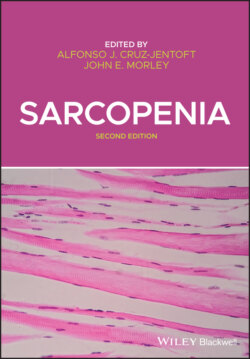Читать книгу Sarcopenia - Группа авторов - Страница 56
What is the basis of protein requirement during aging?
ОглавлениеProtein requirement is defined as the lowest dietary protein intake able to compensate for the obligatory losses of nitrogen from the body and to preserve bodily functions [39]. The current mean dietary requirement for healthy adult men and women of all ages, was set by the 1985 joint FAO/WHO/UNU expert consultation, and estimated to be 0.6 g protein/kg/d, with a suggested safe level of intake set at 0.75 g protein/kg/d [40]. However, because of many changes in body organs functions and metabolism with age, such as body composition, insulin resistance, altered protein metabolism especially in skeletal muscle, some authors [41–44] have suggested that the utilization of dietary proteins and amino acids may differ between the young and the older adults. Consequently, the same authors, using various methodologies, i.e. nitrogen balance and tracer procedures, have tried to define the modifications of protein requirement with advancing age [41–44]. Taken together, studies based on nitrogen balance using the same formula, showed that protein requirement increases in older people, especially in aged individuals during compulsory inactivity such as bed rest [45].
It is generally difficult to establish firm recommendations for protein intake for this population, but it is safe to consider that protein requirement can be slightly increased in older people to limit loss of lean body mass and preserve a better response to any critical stress like sepsis or trauma. Recommendations for dietary protein intake in older persons have been reviewed in 2013 by the PROT‐AGE study group [46, 47]. According to these experts in geriatrics and nutrition, older people should consume an average daily intake of 1.0–1.2 g/kg/d in healthy condition and 1.2–1.5 g/kg/d in disease states, respectively.
This current recommendation is reflected by data from the Health ABC study showing that despite adequate intakes of dietary protein, appendicular muscle mass (reflecting whole body muscle mass) was lost during a three‐year follow‐up and that the less protein is eaten the more muscle is lost [48]. Thus, it is possible that nitrogen balance may not exactly reflect the small changes in protein metabolism that happen every day at a low scale, but cumulating for months can result in a significant decline in muscle protein mass. In this case, it is hypothesized that adaptation of older persons to protein restriction may be inadequate as already reported by Castaneda et al. [49]. This is the reason why most of the research should also focus on the incomplete recovery of muscle mass following stress also called “the catabolic crisis model” [50]. For instance in hospitalized older persons, nitrogen balance studies indicate that a daily intake of 1.3–1.6 g protein /kg/d should be applied [51].
